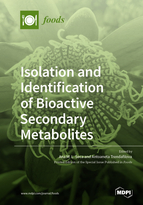Isolation and Identification of Bioactive Secondary Metabolites
A special issue of Foods (ISSN 2304-8158). This special issue belongs to the section "Food Physics and (Bio)Chemistry".
Deadline for manuscript submissions: closed (30 November 2020) | Viewed by 71169
Special Issue Editors
Interests: phytochemistry; secondary metabolites; structural charaterization; bioactive compounds
Special Issues, Collections and Topics in MDPI journals
Interests: phytochemistry; secondary metabolites; isolation; structure elucidation; chemotaxonomy
Special Issues, Collections and Topics in MDPI journals
Special Issue Information
Dear Colleagues,
The health beneficial effects of food, plants, fruits, and seaweeds are the result of the biological activities of their constituents, namely, their secondary metabolites. The study of secondary metabolites and its potential to treat and/or prevent several diseases has become a research topic with growing interest for biologists, pharmacists, and chemists. On the other hand, proposing a compound as a potential new drug with pharmacological effects necessarily implies that the chemical structure of this compound and its biological activity against a given target must be well established.
In this context, original research or review articles on isolation, structural elucidation and biological effects (in vitro or in vivo) of secondary metabolites, from terrestrial or marine vegetal species, will contribute significantly to understanding the role of these compounds, to developing new applications, and to valuing natural sources, in addition to contributing to the welfare of humanity.
As guest editors, we invite and look forward to receiving your contributions to this Special Issue of Foods on “Isolation and Identification of Bioactive Secondary Metabolites”.
Prof. Ana Maria Loureiro da Seca
Prof. Antoaneta Trendafilova
Guest Editors
Manuscript Submission Information
Manuscripts should be submitted online at www.mdpi.com by registering and logging in to this website. Once you are registered, click here to go to the submission form. Manuscripts can be submitted until the deadline. All submissions that pass pre-check are peer-reviewed. Accepted papers will be published continuously in the journal (as soon as accepted) and will be listed together on the special issue website. Research articles, review articles as well as short communications are invited. For planned papers, a title and short abstract (about 100 words) can be sent to the Editorial Office for announcement on this website.
Submitted manuscripts should not have been published previously, nor be under consideration for publication elsewhere (except conference proceedings papers). All manuscripts are thoroughly refereed through a single-blind peer-review process. A guide for authors and other relevant information for submission of manuscripts is available on the Instructions for Authors page. Foods is an international peer-reviewed open access semimonthly journal published by MDPI.
Please visit the Instructions for Authors page before submitting a manuscript. The Article Processing Charge (APC) for publication in this open access journal is 2900 CHF (Swiss Francs). Submitted papers should be well formatted and use good English. Authors may use MDPI's English editing service prior to publication or during author revisions.
Keywords
- Natural compounds
- Phytochemistry
- Edible species
- Plants
- Seaweeds
- Structural characterization
- Bioactive compounds
- Biological activities








